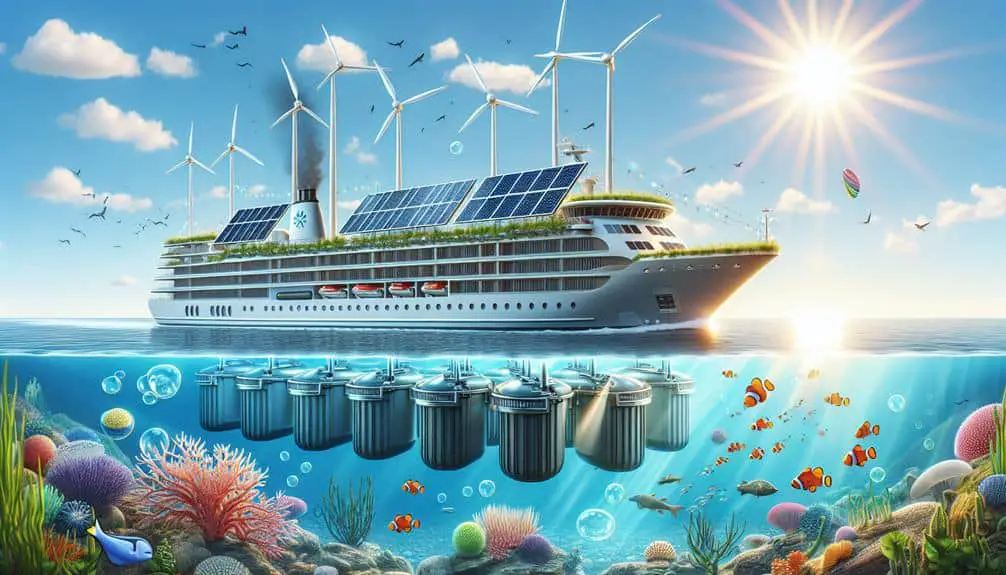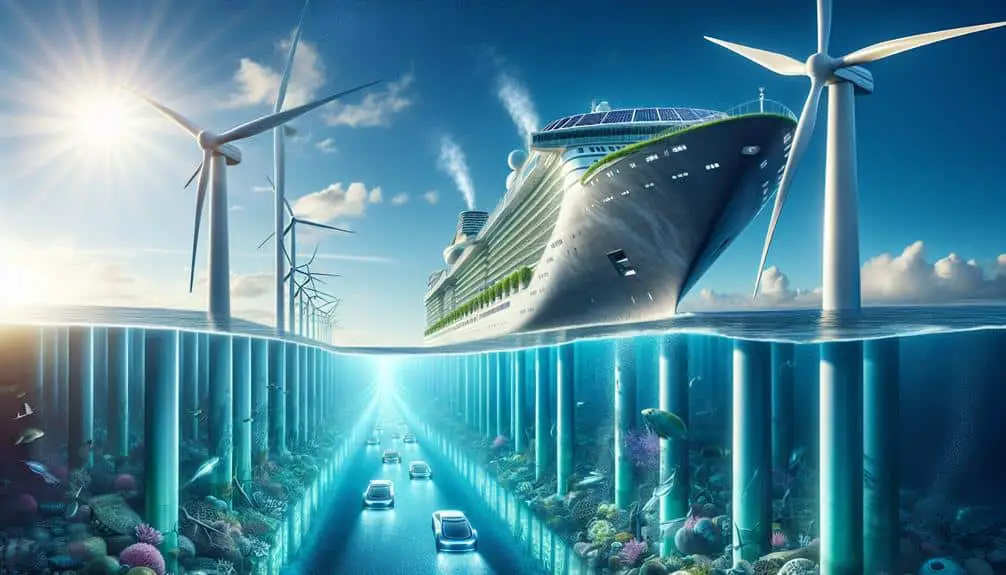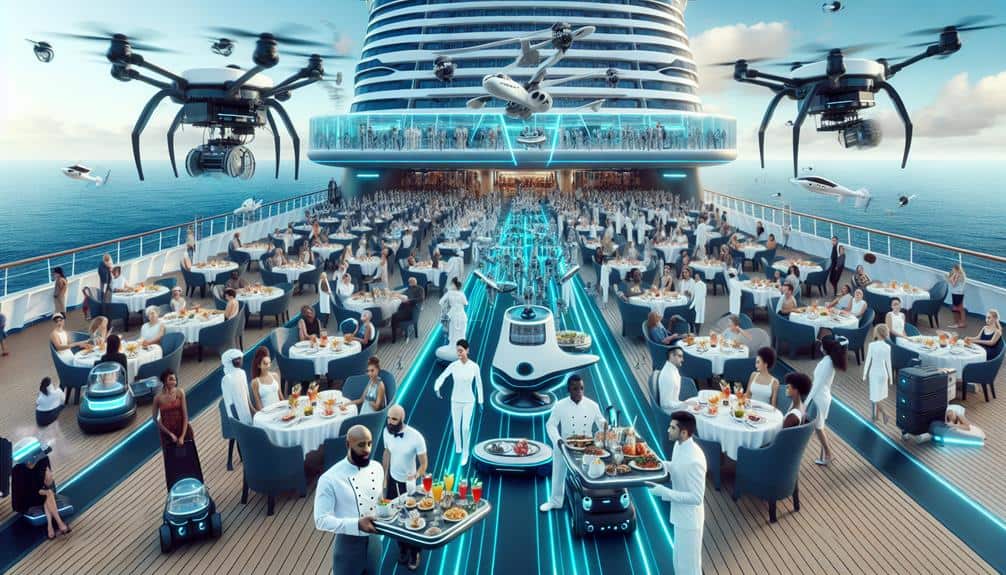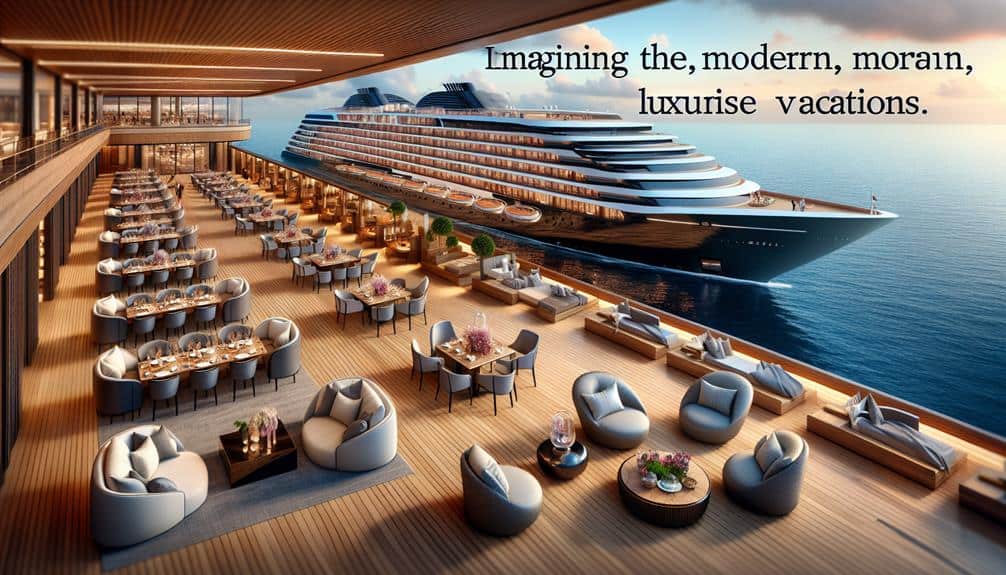Discover how the cruise industry tackles the environment: biodegradable packaging, waste reduction, and composting. Embrace sustainable fuels like LNG, reducing emissions and investing in renewable energy. Protect marine life with conservation programs, cleanup efforts, and awareness-raising. Energy-efficient ship designs include advanced technologies for cleaner operations. Ports reduce emissions with shore power and carbon offsetting, promoting sustainability. Get to know the top five environmental efforts driving the cruise industry towards a greener future.
Key Points
- Implementation of biodegradable packaging to reduce plastic waste
- Adoption of sustainable fuel technology like LNG for emissions reduction
- Marine Life Protection Programs focusing on coral reef conservation
- Energy-efficient ship design innovations for reduced environmental impact
- Eco-friendly port practices to minimize carbon footprint and emissions
Innovative Waste Management Solutions
In the quest for sustainable practices, cruise lines are actively implementing innovative waste management solutions to reduce environmental impact. One key initiative involves the use of biodegradable packaging onboard. By replacing traditional plastics with biodegradable alternatives made from materials like corn starch or sugarcane, cruise lines are greatly reducing the amount of plastic waste that ends up in oceans and landfills. This shift not only minimizes pollution but also sets a positive example for passengers and other industries to follow.
Composting initiatives are another vital aspect of waste management on modern cruise ships. By segregating organic waste such as food scraps and plant-based materials, cruise lines can divert these items from landfills and instead process them into valuable compost. This compost can then be used in onboard gardens or donated to local communities, closing the loop on organic waste and promoting sustainability. Through these innovative strategies, cruise lines are making tangible progress towards minimizing their environmental footprint and promoting a more sustainable future for the industry.
Sustainable Fuel Technology Adoption
By embracing sustainable fuel technology, cruise lines can further reduce their carbon footprint and advance towards a greener future for the industry.
Carbon neutral initiatives are becoming increasingly popular, with cruise companies investing in renewable energy sources and implementing emissions reduction strategies.
One key way cruise lines are achieving this is through the adoption of liquefied natural gas (LNG) as a marine fuel. LNG greatly reduces sulfur oxide emissions and particulate matter, promoting cleaner air quality around ports and coastal areas.
Additionally, community partnerships play an important role in sustainable fuel technology adoption. Collaborating with local stakeholders and governments can help expedite the development and implementation of eco-friendly fuel solutions.
Marine Life Protection Programs
Emphasizing the importance of marine conservation efforts, cruise lines are implementing robust Marine Life Protection Programs to safeguard vulnerable ecosystems and species. Coral reef conservation is a key focus area for many cruise companies, with initiatives aimed at preserving these biodiverse hotspots. Strategies include supporting research projects, implementing sustainable tourism practices around reefs, and educating passengers on the importance of reef protection.
In addition to coral reef conservation, cruise lines are actively involved in ocean cleanup efforts. Through partnerships with environmental organizations, cruise companies organize regular clean-up activities during voyages to remove marine debris and plastics from the ocean. These efforts not only help protect marine life from the dangers of pollution but also raise awareness among passengers about the importance of keeping the oceans clean.
Energy-Efficient Ship Design Innovations
Amid growing concerns over environmental impact, the cruise industry is advancing energy-efficient ship design innovations to reduce carbon emissions and enhance sustainability. To address the pressing need for carbon footprint reduction and green technology integration, cruise lines are implementing cutting-edge solutions:
- Utilization of LNG (liquefied natural gas) as a cleaner alternative fuel source, notably reducing sulfur oxide and nitrogen oxide emissions.
- Installation of advanced air lubrication systems to minimize hull resistance, leading to decreased fuel consumption and lower greenhouse gas emissions.
- Integration of LED lighting technology throughout the ship to reduce energy consumption and enhance energy efficiency.
- Employment of innovative waste heat recovery systems to convert waste heat from engines into usable energy, improving overall fuel efficiency.
- Implementation of streamlined hull designs and propeller enhancements to optimize hydrodynamics and reduce drag, ultimately lowering fuel consumption and emissions.
These energy-efficient ship design innovations showcase the industry's commitment to sustainability and environmental stewardship.
Eco-Friendly Port Practices
Implementing eco-friendly port practices is vital for reducing environmental impact and promoting sustainability in the cruise industry. Ports play an essential role in the overall environmental footprint of cruise operations. One key aspect is the reduction of port emissions, which can be achieved through the use of shore power. Shore power, also known as cold ironing, allows ships to shut down their engines while docked and connect to the local electrical grid, greatly reducing emissions from idling engines.
Another effective practice is carbon offsetting, where ports and cruise lines invest in projects that reduce or remove carbon emissions to balance out their own carbon footprint. This approach helps mitigate the environmental impact of cruise activities on coastal communities and ecosystems. By implementing these eco-friendly port practices, the cruise industry can make significant progress towards sustainability while ensuring a positive relationship with the environment and local communities.
It's imperative for ports and cruise lines to continue investing in and expanding these initiatives to create a more environmentally responsible industry.
Frequently Asked Questions
How Do Cruise Lines Ensure Proper Disposal of Hazardous Waste in Their Waste Management Solutions?
To guarantee proper disposal of hazardous waste in their waste management solutions, cruise lines implement strict protocols, segregate waste streams, use advanced treatment technologies, and adhere to international regulations. Continuous monitoring and audits further enhance compliance and environmental protection.
What Are Some of the Challenges Faced in Implementing Sustainable Fuel Technology on Cruise Ships?
Implementing sustainable fuel technology on cruise ships presents challenges like high initial investment costs and limited infrastructure for refueling. Solutions include investing in research for more efficient technologies and collaborating with fuel suppliers to expand availability.
How Do Marine Life Protection Programs on Cruise Ships Differ From Those on Land-Based Conservation Efforts?
When it comes to marine conservation, wildlife protection efforts on cruise ships involve unique challenges compared to land-based programs. Ships must navigate international waters, coordinate with various ports, and implement onboard initiatives to minimize impacts on marine life.
Can You Provide Examples of Specific Energy-Efficient Ship Design Innovations That Have Been Successfully Implemented in the Cruise Industry?
When looking at energy-efficient ship design innovations, consider solutions like optimizing hull shapes for fuel efficiency, utilizing LED lighting, and integrating renewable energy sources such as solar panels and wind turbines to reduce the vessel's carbon footprint.
What Measures Are in Place to Ensure That Eco-Friendly Port Practices Are Being Followed Consistently by All Cruise Lines Operating in a Particular Port?
To guarantee eco-friendly port practices are consistent among all cruise lines, port inspections are critical. Compliance monitoring and regulatory enforcement mechanisms are in place to uphold standards. Industry collaboration further enhances accountability and sustainability efforts.




